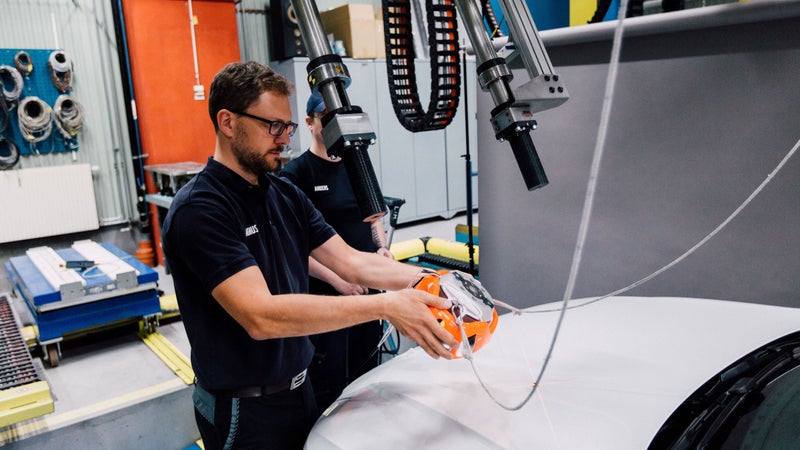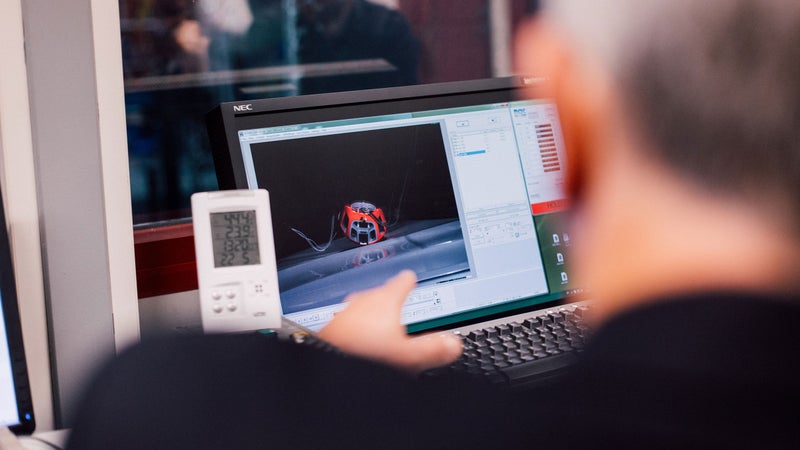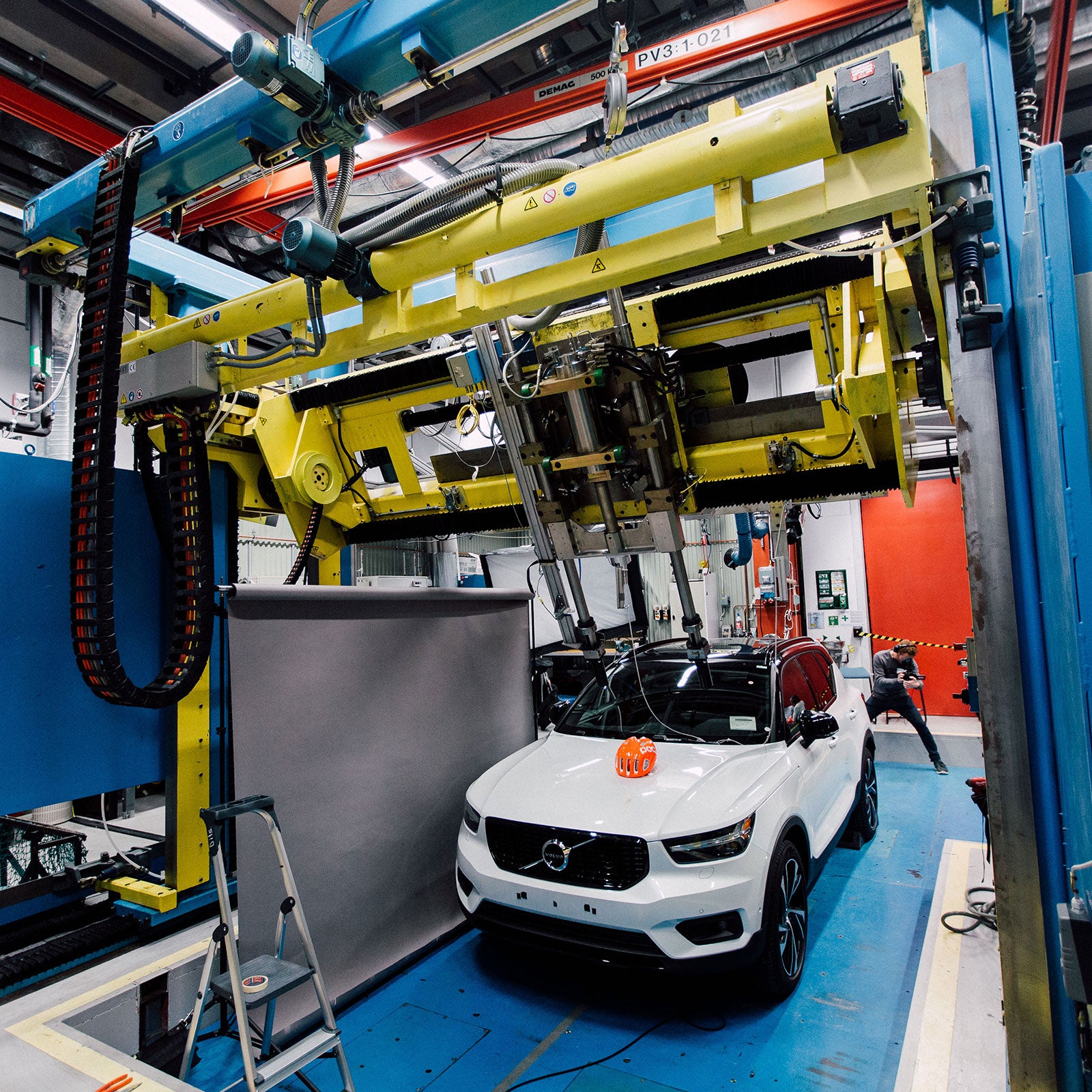For all the importance we place on bicycle helmets to protect our heads in crashes, we still donÔÇÖt know much about how they function in real-world situations, like when a driver hits a cyclist with a car. A between╠řcarmaker Volvo and action-sports brand POC might offer some new insight into those moments, and the two Swedish companies╠řare going to try to find out, with the simplest of approaches: by smashing helmets into hoods in a lab. ╠ř
The testingÔÇöand what POC plans to do with the resultsÔÇömight provide any number of benefits beyond knowing more about the physics of these crashes. Namely, it might enable helmet makers to finally offer more qualitative safety information to cyclists, instead of selling helmets mostly on ancillary benefits like weight and ventilation.
Every bicycle helmet sold in the U.S. must meet impact standards created by the Consumer Product Safety Commission╠řmeant to simulate the force of a riderÔÇÖs head hitting the ground. (There are similar standards elsewhere, in╠řEurope and Australia and New Zealand). But those certification tests, which involve a weighted helmet dropped onto flat (and sometimes also rounded) anvils,╠řhave significant limitations. First, they look only at╠řlinear impact forcesÔÇöhelmets have to meet a minimum requirement in this areaÔÇöand ignore rotational energy, which is thought to be a significant factor in concussions and other closed-head traumatic brain injuries. They also donÔÇÖt account for the fact that, in bike-vehicle crashes, cyclistsÔÇÖ╠řheads donÔÇÖt just hit the pavement.╠řÔÇťItÔÇÖs a combination of both impacts to the vehicle and to the groundÔÇŁ that causes rider injury,╠řsays Magdalena Lindman, a traffic-data safety analyst for Volvo. As Oscar Huss, POCÔÇÖs head of product explains, the impact forces felt on a helmeted head colliding with a car will vary based on what part of the car the helmet hits (more on that in a bit), something conventional certification testing isnÔÇÖt designed to explore.
Second, the test protocols simulate relatively low-speed crashes, below 15 miles per hour, and they donÔÇÖt offer any information about what happens at higher velocities.╠řFinally, they are administered on a pass-fail basis╠řand so donÔÇÖt give consumers any real information about which helmet designs are actually safer than others.

POC wanted to create other test methods to learn more about how its helmets perform in the real world. ÔÇťWe have a pretty long history of trying to look beyond normal test standards,ÔÇŁ says Huss. The brand╠řhas╠řcollaborated with Volvo on safety projects before: POC and VolvoÔÇÖs last collaboration focused on a system to communicate a cyclistÔÇÖs location to a driver, but it never resulted in a physical product, much less wider adoption.╠řThis is the first to involve crash testing. ╠ř
The team didnÔÇÖt have to look far to create a protocol. Since 1997, European auto-safety regulators have required pedestrian-impact testing as part of the (New Car Assessment Programme) protocols for any car sold in Europe. Unlike pavement, a car isnÔÇÖt a uniform, consistent surface: parts like the hood, made of large, flat pieces of sheet metal, deflect under impact, which helps absorb some of the energy of a crash. But elements like the A-pillar, which is essentially part of the carÔÇÖs unibody structure and supports the roof, windshield, and front windows, can be much harder; thereÔÇÖs almost no deflection there. The Euro NCAP testing is, in part, an effort to make those very hard areas of a car a bit more forgiving╠řor spur related technologies like external (pedestrian) airbags.╠ř(If youÔÇÖre interested in how your car fares, you can enter a make, model, and year and get a with an overall pedestrian safety rating╠řand a grid of what zones of each car offer particularly good or bad impact absorption.) In the U.S., the National Highway Traffic Safety Administration╠řhas but never implemented testing, though design changes brought on by European testing still╠řcarry over into car models sold here and the rest of the world.
HereÔÇÖs how it works: testers equip╠řa╠řweighted model head╠řwith accelerometers and other sensors and then shoot it against different parts of a car from different angles, meant to simulate pedestrians of different height.╠ř
POC and Volvo decided to essentially co-opt these tests for use with bike helmets: theyÔÇÖll be slamming weighted helmets into various parts of a car╠řto see how their products do╠řin different crash scenarios. Huss points out that this approach is ÔÇťa little bit more violent than normal [helmet-certification] testing, both in Europe╠řand the U.S.ÔÇŁ╠řWhile the Euro NCAP vehicle tests and the CPSC helmet test use a similar-size headform, for instance,╠řthe NCAP protocol fires the helmets at an impact velocity╠řof 25 miles per hour,╠řalmost double that╠řof the CPSC test, thus resulting in much higher impact forces.
POC does other testing in its own lab, and it isnÔÇÖt the only company doing tests outside the normal certification protocols. Giro, for instance, operates a lab called the Dome. One of its╠řtest protocols, the , involves attaching a headform and helmet to a torso and swinging the whole apparatus into an angled surface to test for rotational energy. Then thereÔÇÖs Virginia TechÔÇÖs STAR rating program, which offers a more qualitative, graded assessment of helmet safety and, crucially, a transparently stated , which includes rotational energy.
POC and Volvo will also be measuring rotational energy in their tests. And in addition to using accelerometers, theyÔÇÖll be recording the studies with high-speed cameras to gather even more data. All of that will offer far more information than they can get from standard helmet-certification testing.
Huss says itÔÇÖs too soon to know what POC and Volvo will learn from the testing and how it might make its way into product design. According to Lindman, once the test protocol is finalized, it will take about six months to collect data. Once they have the test data, Huss predicts POC might be able to incorporate that into helmet technology in as little as one to two years. So the soonest we might expect new helmets that reflect the testing is 18 months.

Real-world testing is tricky; itÔÇÖs unethical to enlist human participants in a study that requires them to crash, and getting naturalistic data is tough because every crash is different. A lab approximation of that is the best that helmet makers can realistically offer. So IÔÇÖm glad POC is doing it.╠řIÔÇÖm also glad theyÔÇÖre publishing the data, which provides something of a path forward to improve╠řhelmet standards. For VolvoÔÇÖs part, Lindman doesnÔÇÖt expect major changes to car design based on the tests, partly because itÔÇÖs already made many of those changes in the course of the mandatory Euro NCAP testing. Besides, she says, the company is more focused on crash-prevention systems, like pedestrian and cyclist detection and active emergency braking.
For all the reasons noted above, the current certification-testing standards are pretty stale. And while various helmet companies do perform additional testing, consumers almost never see any of those results, because helmet makers are (mostly) famously averse to making qualitative safety claims for fear of liability.
Only recently has that started to change, with third-party programs like Virginia TechÔÇÖs. Similarly, since POC plans to publish its results, the company is able to neatly sidestep the safety-claims issue by simply providing data, something I hope more companies start to do. It remains to be seen when and in what form the data is published: whether itÔÇÖs presented in a layout like the STAR system thatÔÇÖs useful for helmet buyers╠řor in a more modest, technical way that at least advances scientific standards within the industry and regulators. The pluses of either approach are obvious. The downside is that╠řsince companies often use different test methods and have a stake in the results, clear comparisons between data╠řcould be difficult. ThatÔÇÖs the attraction of the STAR system (or, for that matter, certification standards): itÔÇÖs independent, and every helmet is tested the same way.
We also donÔÇÖt know if the test results will fit what we see in conventional lab testing╠řor deviate in important ways that raise new questions to answer. But the initiative to try something new in testingÔÇöespecially an attempt to look at how helmets work in the real worldÔÇöis a step in the right direction. Publishing those results is another. ItÔÇÖs like any other scientific effort: only through transparency and collaboration will we get meaningful progress. Perhaps, if more of the data helmet makers gather is out in the open, the bike industry and regulators can finally put together more complete certification testing that better reflects the real world. And╠řthat testing protocol could offer a graded good-better-best approach like the STAR system and, well, every car-safety rating system in the world, rather than the opaque and binary pass-fail approach we have now. WeÔÇÖre a long way from that point yet. But at least weÔÇÖre on the right path.


